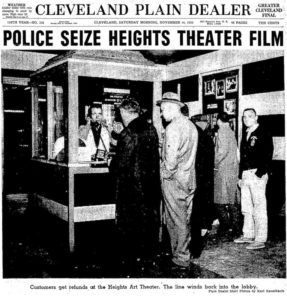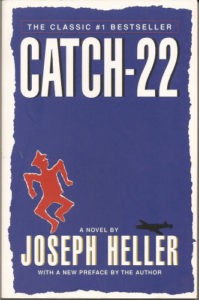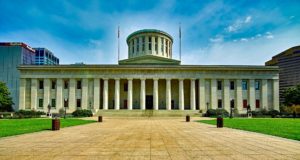Ohio has been home to several landmark freedom of speech cases. These cases arose across the State, in Columbus, Cleveland, Cincinnati, and elsewhere. Each established or followed important First Amendment principles. Several are among the most important free speech cases in U.S. constitutional history.
Here are just a few of the important freedom of speech cases coming from the Buckeye State:
“I know it when I see it”: Jacobellis v. Ohio, 378 U.S. 184 (1964)
 Nico Jacobellis managed a movie theater in the Coventry neighborhood of Cleveland Heights. He was convicted of obscenity for showing a film by Louis Malle called The Lovers. After the Cuyahoga County Court of Appeals and Ohio Supreme Court upheld his conviction, he appealed to the U.S. Supreme Court on First Amendment grounds. Although the Court split on rationale, it reversed his conviction, holding that showing the film was protected free speech. The most famous of the opinions was the concurrence of Justice Potter Stewart. He wrote that he could not define obscenity, “But I know it when I see it, and the motion picture involved in this case is not that.”
Nico Jacobellis managed a movie theater in the Coventry neighborhood of Cleveland Heights. He was convicted of obscenity for showing a film by Louis Malle called The Lovers. After the Cuyahoga County Court of Appeals and Ohio Supreme Court upheld his conviction, he appealed to the U.S. Supreme Court on First Amendment grounds. Although the Court split on rationale, it reversed his conviction, holding that showing the film was protected free speech. The most famous of the opinions was the concurrence of Justice Potter Stewart. He wrote that he could not define obscenity, “But I know it when I see it, and the motion picture involved in this case is not that.”
Incitement of imminent lawless action: Brandenburg v. Ohio, 395 US 444 (1969)
In the late-1960s, a Ku Klux Klan leader named Clarence Brandenburg made a speech at a Klan rally outside Cincinnati, in Hamilton County, Ohio. His hate-filled diatribe advocated violence against African Americans and Jews. As a result, the government prosecuted and convicted him under an Ohio law prohibiting advocacy of “crime, sabotage, or violence” as a means of political reform. The Ohio Supreme Court upheld his conviction. In a seminal free speech decision, the Supreme Court unanimously reversed, throwing out the conviction. The Brandenburg case created what has come to be known as the “incitement” test. Under that test, the Free Speech Clause protects speech that advocates unlawful action—and even violence—unless the speech is likely to produce “imminent lawless action and is likely to incite or produce such action.”
Fighting book banning: Minarcini v. Strongsville City School District, 541 F.2d 577 (6th Cir. 1976)
 Although not a Supreme Court case, one particular Ohio freedom of speech case holds a special place in our hearts at Bolek Besser Glesius.
Although not a Supreme Court case, one particular Ohio freedom of speech case holds a special place in our hearts at Bolek Besser Glesius.
In 1972, the Strongsville City School District banned Joseph Heller’s Catch-22 and Kurt Vonnegut’s God Bless You Mr. Rosewater and Cat’s Cradle. Several high school students sued the School District under the First Amendment. They argued that they had a right to receive information, and their teachers had a right to share it. On appeal, the U.S. Court of Appeals for the Sixth Circuit ruled in favor of the students holding that the School violated the First Amendment, and calling the library a “storehouse of knowledge.”
Minarcini is important because it helped break ground in the fight against government censorship of books. In the words of one scholar, “Minarcini was the first case of its kind to win such victory by having a banned book returned to its school library.”
It is important to us for another reason. The students in Minarcini were represented by volunteer lawyers from the Ohio ACLU. One of them was noted Cleveland civil rights lawyer Howard Besser, the beloved father of our own Matthew D. Besser.
Lawyer solicitation and freedom of speech: Ohralik v. Ohio State Bar Association, 436 US 447 (1978)
In 1974, two Geauga County women were injured in a car crash in Montville Township. A local attorney visited both women—one of them in the hospital—seeking to represent them. After both ultimately fired the attorney, the Ohio State Bar Association found that he violated the Ohio Rules of Professional Conduct by soliciting the clients in-person. The lawyer challenged his subsequent discipline on First Amendment grounds. The U.S. Supreme Court unanimously held that lawyers do not have a First Amendment right to solicit accident victims in-person.
The right to anonymous political speech: Mcintyre v. Ohio Elections Commission, 514 U.S. 334 (1995)
At a 1998 public meeting held by a Westerville, Ohio public school, Margaret McIntyre passed out leaflets opposing a proposed school levy. The leaflets did not include her name and address, as Ohio law then required. When the Ohio Elections Commission fined her, she challenged the Ohio law prohibiting anonymous political speech, represented by David Goldberger (later Matthew D. Besser’s professor at The Ohio State University Moritz School of Law). Ultimately, the case made it to the U.S. Supreme Court. The Court recognized that anonymous political speech is part of our nation’s “honorable tradition of advocacy and of dissent”—practiced by the Founding Fathers themselves. And because the Ohio law chilled free expression, the Court struck down the law.
Religious freedom of speech: Capitol Square Review & Advisory Board v. Pinette, 515 U.S. 753 (1995)
 In 1993, Ohio Ku Klux Klan member Vincent Pinette tried to place an unattended cross on the lawn of Ohio Capitol Building at Christmas. Although Ohio law makes Capitol Square a traditional public forum for free speech purposes, The Capitol Square Review & Advisory Board denied the request. Represented by lawyers from the Ohio ACLU (including the respected Columbus civil rights attorney Benson Wolman) Pinette sued under the First Amendment. In a 7-2 decision, the Supreme Court held that Pinette’s speech was “fully protected under the Free Speech Clause as secular private expression.” Because the Board’s refusal to permit his speech in this public forum did not pass strict scrutiny, it violated the First Amendment.
In 1993, Ohio Ku Klux Klan member Vincent Pinette tried to place an unattended cross on the lawn of Ohio Capitol Building at Christmas. Although Ohio law makes Capitol Square a traditional public forum for free speech purposes, The Capitol Square Review & Advisory Board denied the request. Represented by lawyers from the Ohio ACLU (including the respected Columbus civil rights attorney Benson Wolman) Pinette sued under the First Amendment. In a 7-2 decision, the Supreme Court held that Pinette’s speech was “fully protected under the Free Speech Clause as secular private expression.” Because the Board’s refusal to permit his speech in this public forum did not pass strict scrutiny, it violated the First Amendment.
Ohio lawyers for freedom of speech cases
Nobody can know where or when the next landmark First Amendment case will arise. But if it comes from Ohio, the freedom of speech lawyers at Bolek Besser Glesius stand ready to pick up the mantle as the next guardians of our sacred freedom of speech.

